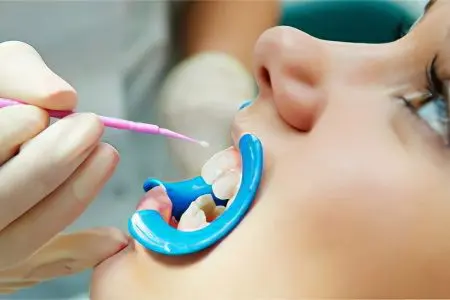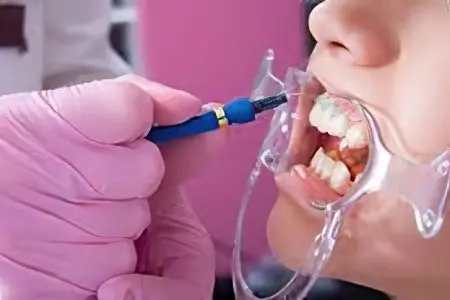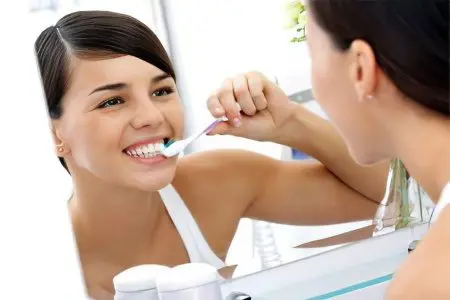Contents
Enamel is a thin coating of the tooth, which is 96% inorganic substances and 2-3% water, organic substances make up only 1% of the enamel. Tooth enamel is the strongest structure of the human body and has the lowest water content in the composition. The inorganic part of the enamel is represented mainly by hydroxyapatites – natural calcium phosphates, which make up 90% of its structure. Saliva contains large amounts of calcium ions and phosphate ions, and, washing the teeth, protects them from destruction and replenishes the mineral composition of the enamel.
In some parts of the tooth, the thickness of the enamel layer can reach 2-2,5 mm. Behind the enamel is a less durable layer – dentin, which is more susceptible to destruction by pathogenic bacteria. That is why it is so important to keep the enamel healthy and intact for the prevention of caries and other dental diseases.
Symptoms of enamel destruction

With all the strength of tooth enamel, it is not absolutely invulnerable and is subject to destruction under the influence of certain factors. Enamel thinning and defects lead to a deterioration in the condition of the teeth, an increase in the risk of carious destruction of all its tissues, which do not differ in such hardness. This situation is also dangerous because the enamel cannot be regenerated on its own, and the restoration of its mineral composition is possible only artificially.
The thickness of the enamel is not the same in different parts of the tooth surface. So, on the chewing surface, this layer reaches two millimeters, gradually thinning closer to the root of the tooth. The chewing surface of the tooth most of all needs such a durable coating, since it has a large functional load. Nevertheless, the basal areas of the tooth remain the most vulnerable area, most often the reproduction of microorganisms that provoke caries begins from here. After the destruction of the enamel, the pathogenic microflora easily moves deep into the tooth, to the very pulp, especially since the dentin (the second tissue layer after the enamel) has a porous and relatively soft structure. Carious cavities are formed, which often reach such sizes that only a filling is not enough to restore a tooth, but prosthetics are necessary.
It is possible to determine enamel damage at an early stage and prevent dental diseases that inevitably follow when the protective layer of tooth enamel is destroyed, according to the following symptoms:
Sensitivity of the teeth, which is manifested by a painful reaction – nagging sharp pain in response to exposure to cold, hot food and drinks, acidic fruit juices and mechanical stress during chewing;
Increased pain with minimal irritation – pain accompanies even the process of breathing, even with air of normal temperature;
Tarnishing of the enamel – it acquires a gray tint, the shine disappears;
The appearance of spots on the enamel, its yellowing;
Carious lesions of the tooth, at an early stage of which its surface becomes chalky and becomes rough; in later stages, cavities appear and the tooth darkens.
What factors provoke enamel damage?
The following factors lead to damage to the enamel:
Enamel damage, thinning and cracking on its surface can be a sign of a lack of fluorine and calcium minerals, as well as a lack of vitamins; (read also: Causes and symptoms of beriberi)
The opposite situation, in which too much fluorine enters the body, provokes fluorosis, which also worsens the condition of the enamel, causing spots on its surface.
Whitening procedures for teeth, both professional and homemade, using soda, fruit acids and hydrogen peroxide also thin the enamel and increase the sensitivity of teeth to external irritating factors, up to a painful reaction to the inhaled air.
Hereditary predisposition – enamel is more often damaged in those people who have a thin layer of it by nature;
Improper hygiene – a toothbrush of increased rigidity for teeth with thinned enamel, a lack of habit of rinsing your mouth after eating and brushing your teeth twice a day.
Diet foods rich in acids, such as citrus fruits and other acidic fruits. Acids with daily use gradually thin the enamel, washing away minerals from it, which is a prerequisite for its destruction.
Excessive mechanical stress on the teeth – too hard food that needs to be thoroughly chewed, the habit of opening bottles and cracking nuts with your teeth, cracking seeds; enamel can deteriorate in people who bite their nails;
Smoking, chocolate and other sweets, alcohol, sweet soda and coffee in large quantities also adversely affect the condition of tooth enamel;
Anatomical features of the structure of the teeth, for example, deep and branched fissures;
Systemic diseases affecting the general condition of the body;
The chemical composition of saliva. Saliva is a natural antibacterial and cleansing agent, protects teeth from damage by pathogenic bacteria and maintains the stability of the mineral composition of teeth;
Problems with the digestive system;
Teeth fluoridation

Fluorine is a mineral that occurs naturally as a phosphate rock and is essential for healthy teeth and normal enamel formation. Enamel thinning can be observed in people whose diet during the period of formation of dental tissues lacked sufficient amounts of fluoride. That is why many toothpaste manufacturers add fluoride to their composition, and dental clinics offer teeth fluoridation.
Restoration of the mineral composition of tooth enamel with the help of fluoride helps to reduce its damage, prevent thinning and cracks. This is a good prevention of caries, and also helps to relieve tooth hypersensitivity to cold and heat, sweet and sour foods.
In some regions, tap water is specifically subjected to fluoridation; residents of such areas have carious lesions and other dental diseases that are 60% less common than residents of areas where water is chlorinated.
However, fluoridation of teeth should be carried out with caution, since an excess of fluoride in the body is more dangerous than its lack. Residents of regions where water contains a high concentration of fluoride may suffer from darkening of the enamel, the appearance of yellow and brown spots on it. Therefore, fluoridated water can be used during brushing your teeth and for domestic purposes, but it is not recommended to drink it. Dental fluoridation of teeth using fluorine varnish is carried out no more than once every six months.
Remineralization of teeth
In addition to fluoridation, the teeth remineralization procedure, which also takes place with the use of a special varnish, is highly effective. In addition to fluorine, remineralization varnish contains a lot of other useful components that restore the mineral composition of enamel and prevent its destruction. Remineralization is carried out with the same frequency as fluoridation – every six months. Its advantages include minimizing the risk of fluoride oversaturation, which distinguishes remineralization from fluoridation.
Enamel restoration with remineralization varnish is not carried out at once, it is necessary to undergo a course of procedures that give a cumulative effect.
What to do if the enamel is badly damaged?

If the damage to the enamel is minor, then the previous methods of its restoration are sufficient. However, if the defects are too obvious and severe, a simple varnish application procedure, which can be carried out even at home, is not enough. In this case, one of the following methods should be used.
Implantation
Implantation is a modern dental procedure that consists of applying a composition to the enamel, which is 90% similar in composition to the natural covering of the tooth. The engraftment of an artificial protective layer with enamel occurs at the cellular level, while the appearance of the teeth becomes much more even and shiny, without minor defects such as scratches and chips, but they look completely natural.
The disadvantages of the procedure include its high cost and lack of popularity – not every dental clinic can carry it out correctly.
Composite restoration
Noticeable enamel defects such as scratches and chips are restored using composite materials used in dental fillings. The composite is applied in layers to the damaged surface, allowing it to harden under a halogen lamp. In order for the tooth to retain its natural shape, it must be ground.
The advantages of this method are affordable price, aesthetics, the ability to correct serious damage to the enamel and long-term. The service life of the composite coating is about five years.
The main disadvantage of composite restoration is its harm to tooth enamel. The composite replaces the natural protective coating of the tooth, while damaging the actual enamel.
Ceramic veneers
Porcelain veneers are thin plates that are installed on the front surface of the tooth, allowing you to hide the aesthetic defects of the enamel and correct other imperfections – too large distances between the teeth, the curvature of their growth.
In terms of aesthetics and longevity, veneers are an excellent option, they are absolutely indistinguishable from your own teeth, make them visually more attractive and do not require replacement for at least ten years. The disadvantages of this method include, firstly, a relatively high price, and secondly, irreversible damage to the enamel after their application. If you installed veneers once, then you will have to use them all your life, or resort to even more expensive restoration methods. After removing the veneers, the tooth surface remains absolutely defenseless to any external irritant, chemical or mechanical.
How to save tooth enamel?
Do not ignore preventive examinations at the dentist every six months – this will help you avoid serious complications and solve the problem in the bud. In addition, it will significantly save your money, since remineralization at the first stages of enamel damage is much cheaper than subsequent caries treatment and dental restoration;
Do not ignore the rules of oral hygiene, even if you are on vacation or on a business trip. Familiarize yourself with the correct method of brushing your teeth and select a toothbrush of optimal stiffness, do not abuse whitening and fluoride toothpastes;
Adjust your diet and habits in such a way as to reduce the number of factors that provoke enamel damage. Refrain from eating sweets, sour fruits and juices from them, alcohol and coffee;
Give up the habit of biting your nails, cracking seeds and opening bottles with your teeth;
Enrich the menu with products that are rich in trace elements and vitamins. In the autumn-winter season, take multivitamin complexes.
How much do tooth restoration procedures cost?
Remineralization and fluoridation procedures with special compounds are affordable, their prices start at 50 rubles per tooth, they can be carried out either for all teeth, or only in problem areas with increased sensitivity.
Composite restoration and veneers will cost more – restoration within 3-4 thousand rubles, prices for veneers start at 10 thousand.
Restoration of tooth enamel at home

Enamel restoration can be carried out without special procedures, simply by observing the rules of oral hygiene. We are talking about brushing your teeth, but to remineralize the protective coating of the teeth, you need to use toothpaste or powder that contains fluoride. These hygiene products can be used by both adults and children, moreover, since 1984 the World Health Organization recommends pastes containing at least 2 mg of fluorides – sources of fluoride ions.
Among fluorine salts in the production of hygienic dental care products, the following substances are used:
Lead fluoride;
sodium fluoride;
Monofluorophosphate;
Aminofluorides (organic fluorine compounds).
They are necessary to increase the resistance of tooth enamel to metabolites of carious bacteria, inhibit the reproduction of plaque microbes and maintain a constant remineralization process. Active fluorine (ions of a substance that are in an unbound form in solution) is one of the most necessary compounds for the prevention of caries.
To restore the mineral composition of enamel at home, fluorinated toothpastes, rinses, mouthguards with fluoride-containing gels, self-massage of the gums to increase blood circulation and nourish tooth tissues are used:
Mouthwashes contain ingredients that not only prevent the formation of plaque on the teeth after eating, but also maintain healthy gums and promote enamel remineralization. Therefore, while rinsing the mouth with special means, it is recommended to keep the solution in the mouth for some time (1-2 minutes) so that the active ingredients act on the surface of the tooth.
To enrich tooth enamel with fluorides, mouth guards filled with fluoride gel are also used. There are two ways to use them: express fluoridation, which is usually offered by dental clinics, and the drip method for home use. The express technique involves keeping a disposable mouthguard with gel on the teeth for a short time period (5-10 minutes). Self-fluoridation is carried out with a kappa, made individually, taking into account the structural features of the jaw and the growth of the patient’s teeth. The fluoride gel that is filled into the tray can be left on for several hours or overnight.
A typical toothpaste is usually fortified with sodium fluoride (up to 0,76%) or monofluorophosphate (up to 1,14%). Children’s pastes are much less rich in fluorides (up to 0,02%), which is necessary for the safe use of the cleansing composition on young gums and growing tooth enamel. Some pastes also contain silicon and calcium salts, which produce an abrasive effect. Together with fluorides, they constitute a system for the restoration and whitening of enamel with the prevention of caries, which is called Fluoristat.
Other beneficial additives include a substance such as triclosan. Triclosan in toothpaste is found together with a copolymer, a substance that prolongs its action up to twelve hours after the last brushing. Triclosan prevents the growth of tartar crystals and inhibits the vital activity of pathogenic bacteria, both gram-positive and gram-negative. This prevents the formation of soft plaque and the destruction of tooth enamel by metabolites of pathogenic microflora.
Author of the article: Muravitsky Boris Viktorovich, dentist, specially for the site ayzdorov.ru









